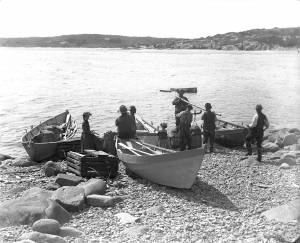An online project under the direction of the CAPE ANN MUSEUM
Historical Materials: Maritime & Other Industries & Facilities
Historical Materials » Maritime & Other Industries & Facilities » Lobstering
Lobstering
View related Fitz Henry Lane catalog entries (4) »
Prior to 1840, the lobster fishery had but a minor role in the American fishing industry. The market was limited by the difficulties of transporting live lobsters over long distances, which kept the demand local. As transportation (by rail), improved, the market broadened and demand increased, leading to more fishing and reduction of lobsters, both in size and in numbers.
In Lane's later years, the fishery was growing, but significant decreases of lobsters were not yet considered serious. Decrease in numbers of very large lobsters (weighing ten pounds or more) was noted, but clamors for regulations on sizes and numbers of lobsters caught were not heard until the 1870s.
Lobster traps in the nineteenth century were mostly of the "round top" design—built of wooden laths with funnel-shaped entries of netting at both ends. The tops were hinged "lids" providing access to the catch; stones were fitted as weights to the flat bottom.
The pots could be set individually or in "strings" with marker buoys at both ends of the string. Individual pots were set on rocky bottom where a string of pots could become fouled and lost. Strings of pots were best for a smooth bottom when lobsters were moving inshore in large numbers. When lobsters were scarce on smooth bottoms, individual pots were set, being easier to move to other places.
Once caught, lobsters were kept in floating boxes (called "cars") with open seams and bored holes to allow water to circulate. A lobster car with a "killick" (stone anchor) is depicted by Lane in the foreground of Gloucester Inner Harbor, 1850 (inv. 240).
– Erik Ronnberg
Reference:
G. Brown Goode, "Fisheries and Fishery Industries", Section V, Vol. 2, 658–74.
In G. Brown Goode, The Fisheries and Fishery Industries of the United States (Washington, DC: Government Printing Office)
Cape Ann Museum Library & Archive, Gloucester, Mass.
See pl. 247.
This photo was most likely taken in Ipswich Bay on the north shore of Cape Ann (visible in right background). During the warm months, lobsters migrate to the shore where they feed and shed their outgrown shells while hiding among the rocks. Dories are the lobstermen's choice for working traps out in the bay or close to shore in rocky shallows. Pots can be set individually or in strings, the latter on smoother ground where the line is less likely to be fouled.
– Erik Ronnberg
In G. Brown Goode, The Fisheries and Fishery Industries of the United States (Washington, DC: Government Printing Office)
Cape Ann Museum Library & Archive, Gloucester, Mass.
See pl. 249.
Lobster Cove (Lane's Cove) was a thriving port for the Ipswich Bay shore fisheries from colonial times through the 19th century. Even as late as the mid-20th century, the waterfront was lined with sheds for fishing gear - now all gone. In addition to lobstering, gill-netting, trap fishing, hand-lining, and seining (small-scale) were carried on at various times in pursuit of numerous fish and shellfish types.
– Erik Ronnberg
Also filed under: Folly Cove »
Glass plate negative
4 x 5 in.
Cape Ann Museum Library & Archive
#10205/418
Also filed under: Folly Cove »
Glass plate negative
Collection of Erik Ronnberg
Also filed under: Schooner (Coasting / Lumber / Topsail / Packet / Marsh Hay) »







